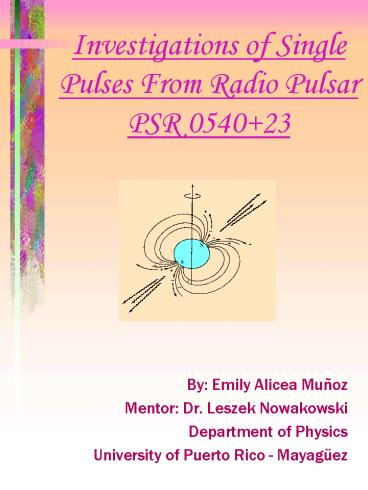Investigations of Single Pulses From Radio Pulsar PSR 0540 23 - PowerPoint PPT Presentation
1 / 7
Title:
Investigations of Single Pulses From Radio Pulsar PSR 0540 23
Description:
Drifting subpulses. Core and conal components. Total power. The ... This pulsar presents some subtle drifting subpulses. The pulsar also presents nulling. ... – PowerPoint PPT presentation
Number of Views:30
Avg rating:3.0/5.0
Title: Investigations of Single Pulses From Radio Pulsar PSR 0540 23
1
Investigations of Single Pulses From Radio Pulsar
PSR 054023
- By Emily Alicea Muñoz
- Mentor Dr. Leszek Nowakowski
- Department of Physics
- University of Puerto Rico - Mayagüez
2
The Discovery of Pulsars
- Pulsars were discovered in 1967 by Jocelyn Bell,
a graduate student under the supervision of
Antony Hewish. The pulsars showed up as periodic
radio signals. - Now, we know over 1200 of them.
What is a pulsar?
- The accepted theoretical model indicates that
pulsars are magnetized, rotating neutron stars,
which are formed after supernova explosions, as a
result of the gravitational collapse of the
remaining core of a massive star.
3
Our Main Objective...
- We know how pulsars behave, but we do not know
why they behave the way they do. - Our main objective is to find out what is the
physical process that makes pulsars work.
Instrumentation
- Pulsars are observed using radiotelescopes. We
are using the Arecibo Radiotelescope, a spherical
dish with a diameter of 305 meters, which is the
largest and most sensitive instrument of its kind
in the world.
4
The average profile
- When you take a long stream of pulses and divide
it into equal pieces of the same length as the
pulsar period, and then add them up, you get the
integrated or average profile. - Each pulsar has a characteristic average profile,
whose shape, width and structure are unique to
that pulsar.
What we are analyzing...
- Signal to noise ratio
- Mode switching
- Nulling
- Drifting subpulses
- Core and conal components
- Total power
5
Preparation of the data
- Dedispersion
- Baseline removal from individual pulses
- Data
- Sample numbers
- Calibrated or Non-calibrated samples
- Receivers and channels PSPM
PSR 054023 The Procedure
- Visual inspection of the data
- Baseline removal from each pulse
- Normalization
- Integration in intensity bins
- Integration in subwindows
- Histograms
6
What have we learned...
- The average profile of PSR 054023 has one strong
component. - This pulsar presents some subtle drifting
subpulses. - The pulsar also presents nulling.
What we are doing next...
- Use data with higher time resolution, so that we
can see more details and improve the signal to
noise ratio. - Analyze the polarization of the radiation from
this pulsar.
7
References
- Manchester, Richard and Taylor, Joseph. Pulsars.
W.H. Freeman and Company. San Francisco, 1977. - Nowakowski, Leszek. New Features in Two Radio
Pulsars PSR 154109 and PSR 113316. The
Astrophysical Journal. February, 1996. - Rankin, Joanna. Toward an Empirical Theory of
Pulsar Emission - I. Morphological Taxonomy. The
Astrophysical Journal. November, 1983. - URL http//www.naic.edu

